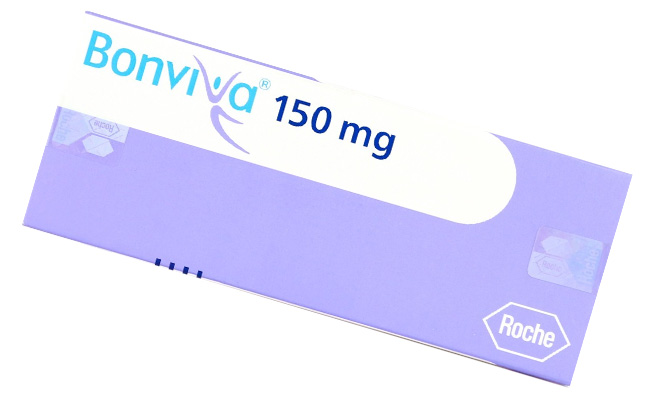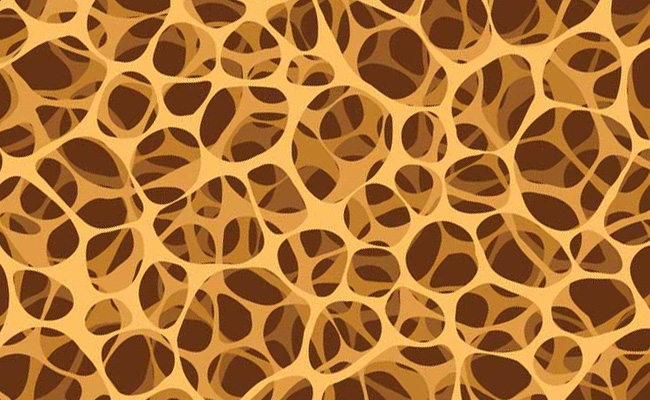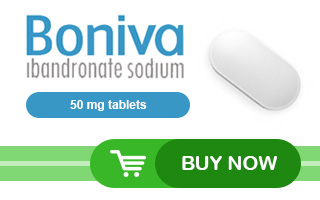BONIVA
(ibandronae sodium)
Boniva is medication for women with postmenopausal osteoporosis, you need only one tablet a month.

Packet of medicine Boniva (ibandronae sodium) tablets 150 mg
Composition of Boniva
The molecular formula of the drug is C9H22NO7P2Na•H2O with a molecular weight of 359.24 g. Ibandronate sodium is an off-white-to-white powder which is insoluble in organic solvents and freely soluble in water. Boniva is a white, 150 mg, oblong, film-coated monthly oral tablet.
Uses of Boniva
Boniva is used to stop and cure certain types of osteoporosis (bone loss). Osteoporosis reduces the thickness and strength of the bones. The possibility of developing is increased after menopause, or if corticosteroid medicines (like prednisone) are consumed for long durations. This medicine works by slowing down the process of bone loss to help the maintenance of strong bone and decrease the risk of fractures (broken bones).
How to Use Boniva
This medication is administered orally generally once in a month and should be taken each month on the same date. The medicine is preferred to be taken after waking up in the morning and at least an hour before the first meal. The medicine should be swallowed and then the person should stay completely upright for at least an hour. After taking ibandronate, you should wait before eating or drinking anything except plain water.
Side-Effects of Boniva
Stomach- ache, pain in legs/arms, diarrhea, mild flu may occur. The Doctor should be informed if any severe side-effects such as the following are observed:
- Severe joint pain
- Unusual thigh/hip/groin pain
- Jaw pain
- Vision changes
- Severe heartburn
- Difficultly in swallowing
- Severe abdominal/ stomach pain
- Tarry/black stools
- Ulcers in esophagus or stomach
Allergic reactions such as swelling, rash, itching of tongue, face and throat, trouble breathing and severe dizziness may occur rarely.
Contraindications of Boniva
If you are allergic to ibandronate or any other biphosphonates like etidronate, risedronate, alendronate or pamidronate, then inform your doctor before taking the medicine. Medicines such as didanosine, quinapril, bismuth subsalicylate and sucralfate may hinder the ibandronate absorption. Iron or Calcium supplements, antacids containing aluminium, magnesium or calcium, and food like dairy products (such as yogurt, milk), calcium supplemented juice and mineral water may also obstruct the absorption. The doctor should be well informed about your past medical conditions especially of: hypocalcemia (low calcium levels in blood), esophagus disorders like heartburn, achalasia), intestinal/stomach problems or severe kidney disorders. Boniva may also cause inflammation of the upper GI (Gastrointestinal) problems.
Boniva during Pregnancy
This Medication is not recommended during the pregnancy period or future pregnancy plans. It should be used by pregnant women only if the potential risk is less than the potential benefit to the mother and unborn baby. This is because boniva stays in the body for several years. The effects of this drug on the infant are not known yet. It is even unknown whether the drug penetrates through the breast milk or not. Because several drugs are released into the human milk, caution is advised while administering boniva to a nursing female.
Symptoms, Effects, and Remedies of Osteoporosis
Osteoporosis or how it is commonly known as thinning bones is a condition which may lead to several painful fractures. This is characterized by a significant decrease of the bone density thus decreasing their strength and making them fragile. Osteoporosis makes the bones abnormally porous which make their consistency quite similar to a sponge. This disorder makes the bones weak and thus hampering the skeletal structure of the person. This results in recurrent fractures of bones.
The risk factors for osteoporosis include many health factors like aging, body weight, menopause, and smoking. Women are the one affected by this disorder.

Illustration Of Osteoporosis Bone
Chief causes of Osteoporosis
- Age: Women in their late 30s are most prone to this
- Bone structure: Small and petite bone structure is at higher risks
- Ethnicity: Asian and white women are most prone to this
- Genetics: Sometimes this is hereditary and is inherited if a parent has serious fracture history or the disease
Symptoms
There are not many outward, and visible symptoms of osteoporosis since the bone density loss is an inward process. Tiny incidents like a strain or sneeze can sometimes prove to be fatal for osteoporosis.
Here are some symptoms that stay as a constant reminder of the thinning bone disease:
- Back pain which can be a result of either fracture or even disfigured vertebrae.
- The height of the woman shrink over the time
- The posture begins to stoop which can end in a disfigured and arched spinal cord.
- Chances of bone fractures amplify in comparison to general terms.
Effect of Osteoporosis
The effect of osteoporosis cannot be regarded at once. It has a long course before the effect is finally visible and is such a wicked disorder that there are not many scopes of complete recovery. These are means and ways to deal with the pain and decaying process but not a final solution to steer clear of the pain.
- Lear about Bone Tumor
Hip fracture
Hip is one of the two primary and adverse effects that is a result of suffering from osteoporosis. It is a matter of concern because there is a serious lack of calcium and Vitamin D in your body. You must seek medical help like physiotherapy to cope with it, and for handling serious measures, surgery is well recommended. Broken hip makes it tough for you live through the every day works, so it is best to look out for situations avoiding a broken hip.
Spinal Cord Fracture
Spinal cord fracture can result in severe back pain, height loss, deformity, reduced pulmonary activities, and immobility. Apart from the physical burden, there is a long-lasting negative impact on mental health that can lead to depression. A spinal cord injury increases the possibilities of other injuries.
Remedies for prevention of Osteoporosis
There are not remedies to keep this disease away if you have a gene for this, but there are lifestyle choices and other ways apart from the medical way through which you can keep the risk and possibility of osteoporosis away. Those are:
- Adequate calcium intake in the form or diet or supplements
- Adequate Vitamin D through food, sunlight or supplements
- Quit smoking if possible as smoking kills the estrogens level
- Check alcohol consumption
- Insert light free-hand exercises in your everyday routine
These are the way you can know if you’re to suffer from this slow and decaying disease of osteoporosis. It is a wicked disease with treatment and betterment but no complete cure.

